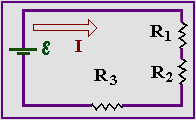Electrical Circuits
A basic circuit consists of the following three elements:
- A power supply that supplies a voltage
- one or more resistors that modulate the voltage to produce
the desired level of current in the circuit
- a device (like a light bulb) that can be powered by a
certain level of current
As discussed previously, voltage, resistance and current are all
related via Ohms law.
In the two circuits below, the number in the light bulb specifies
the desired amount of current (in amps) that the circuit needs to
light the lightbulb.
If you fully understand Ohms law, you should be able to drop the right
amount of resistance in on the very first try. So go ahead.
Now its time to discuss how basic electrical circuits are constructed. The key concept to retain is that a circuit in which the resistors are connected in series means that there are no branching points for the current. A circuit which contains resistors in parallel means that the current can be branched and rerouted.
Resistors in Series:

Note that in the following, we use the symbol,
 (the
electromotive force) to represent voltage. (the
electromotive force) to represent voltage.
The circuit in the figure above
shows three resistors connected in series, and the direction of current is indicated by the arrow.
Since there is only one path for the current to follow (i.e. there is no
branching point in this circuit) then the current is everywhere the same
in this circuit no matter where you are in the circuit.
I = I1 = I2 = I3
 Across each resistor there is a voltage drop (think of this as the
following: each resistor represents a point of energy dissipiation)
The sum of all the voltage drops across the 3 resistors as to equal
the total supplied voltage.
Across each resistor there is a voltage drop (think of this as the
following: each resistor represents a point of energy dissipiation)
The sum of all the voltage drops across the 3 resistors as to equal
the total supplied voltage.
V = V1 + V2 + V3
The total resistance in this circuit is simple the sum of the individual
resistances of all the resistors in series.
R = R1 + R2 + R3
For any given resistor, Ohms law is also satisfied. That is,
V1 = R1I1
Now, since I1 = I then we have the generic condition for each
resistor n:
Vn/Rn = I
For any circuit where the resistors are in series. Series circuits are
pretty easy to understand if you just visualize that the current only
goes one way.
| 